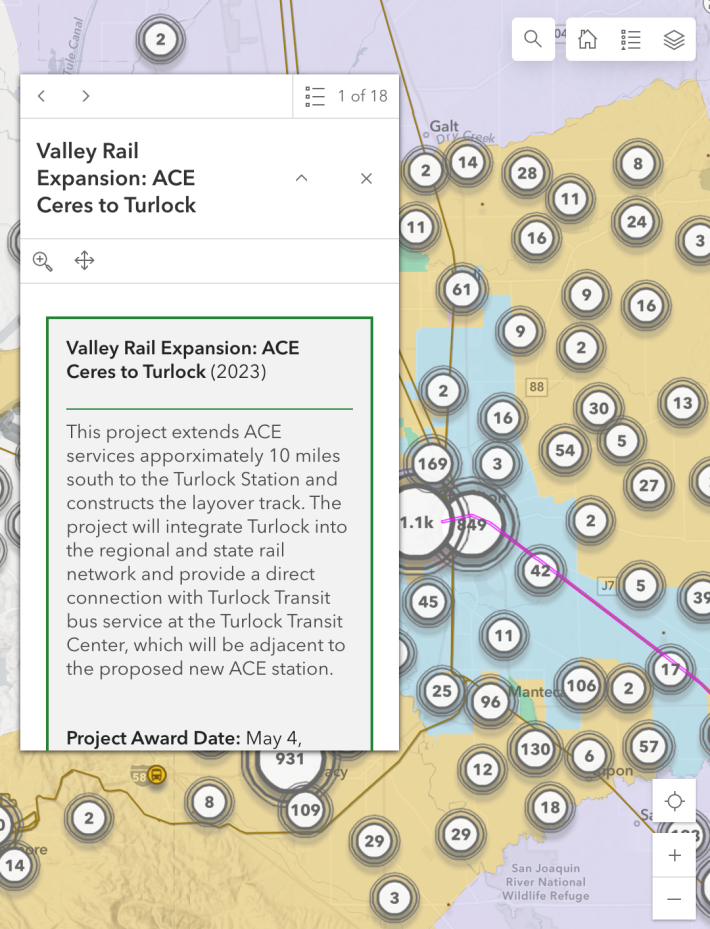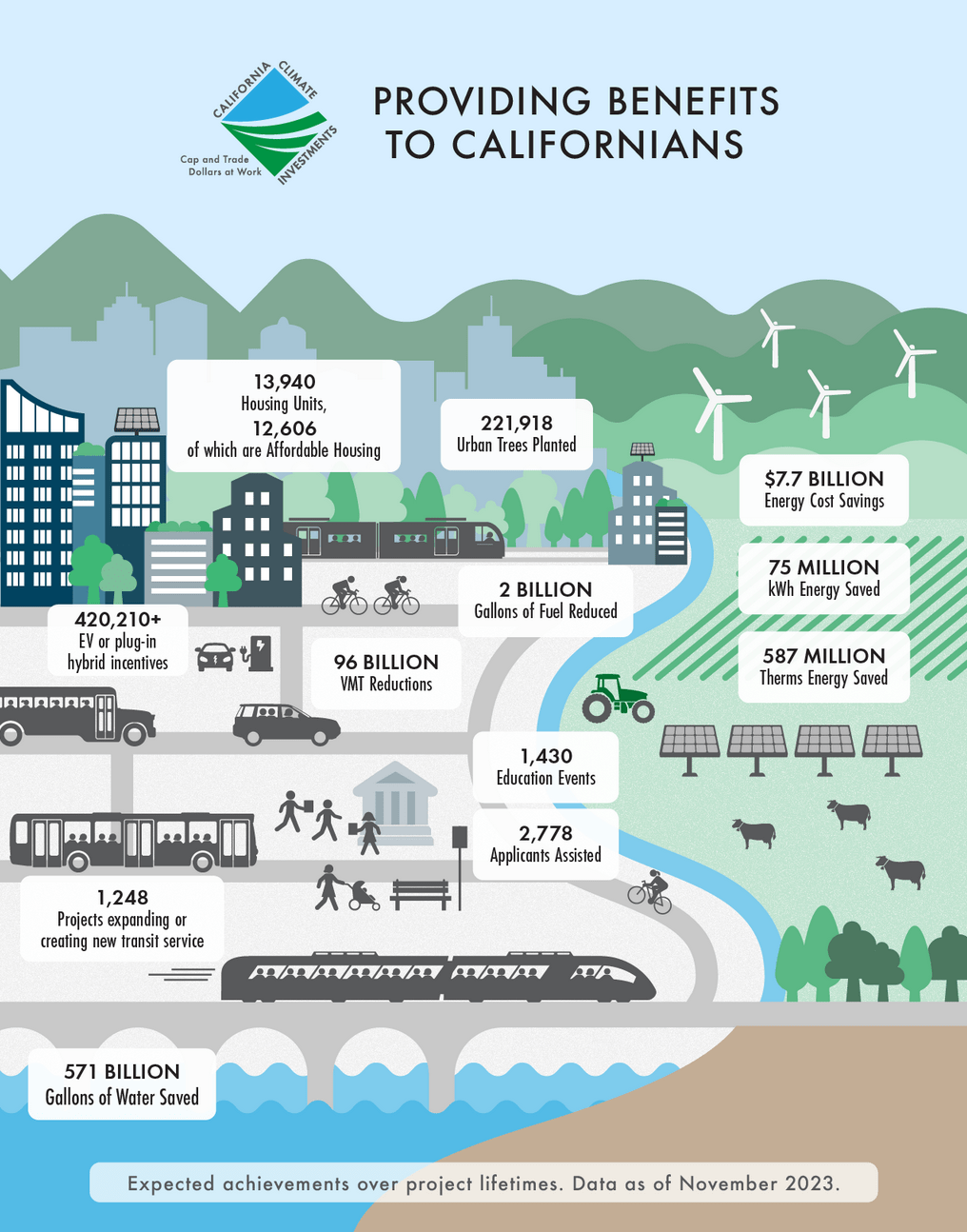In 2014, California's Cap-and-Trade Program began allocating revenues from its nascent cap-and-trade auctions. For several years there was a lot of discussion about where that money should go, while various factions kept trying to undermine it and cast doubt on its potential for success.
Fast forward ten years, and a lot of progress has been made. While the notion of cap-and-trade - in which industries basically pay to pollute - has some fundamental flaws, it is the choice California made in 2006 to try to reduce greenhouse gas emissions. And it is definitely raising money.
According to a just-released report from the California Air Resources Board, California’s Cap-and-Trade Program has provided over $28 billion in climate investments over the last ten years Almost half of that - $11 billion - has already been implemented by way of more than half a million projects across the state, creating 30,000 jobs.
The report also asserts that the program has "wiped out emissions equivalent to taking eight percent of the state’s gas cars off the road."
Note, however, that those cars haven't actually been removed. Cap-and-trade investments in transit and electric vehicles are very helpful and necessary, but they are dwarfed by ongoing state investments in highway expansion - which tends to lead to more cars on the road. Making equivalencies between emissions reductions and "cars on the road" is a popular way to try to explain what those tons of avoided emissions might mean - but it's misleading and ultimately unhelpful.
Nevertheless, the programs that are funded by cap-and-trade have definitely had a positive impact on greenhouse gas emissions, even if the state is not yet close to solving the problem of climate emissions. Those programs include affordable housing near job centers, high-speed rail, and bringing zero-emission transportation options and infrastructure to underserved communities.
The report says cap-and-trade produced 420,000 rebates for zero-emission vehicles, 32 million new trees planted in urban and wildland areas, 12,600 affordable housing units (under contract), 1,428 new or expanded transit projects, and those aforementioned 30,000 jobs. Twenty-four state agencies are involved with administering a wide range of programs funded by cap-and-trade, ranging from waste diversion, to energy storage and strengthening the grid, to working with tribal groups on incorporating traditional land practices to protect natural and working lands and removing dams, to managing clean energy incentive programs, to building affordable housing near transit, to improving transit.
In addition, more than three quarters of those projects spend that money within underserved and low-income communities, which California recognizes are the ones that face the greatest burdens from pollution and climate change.
Administration officials making the announcement were understandably proud of this impact, and of the leadership California has provided to some forty other cap-and-trade programs worldwide, as well as the federal government's Justice 40 initiative that focuses on investing in communities that have been underserved and harmed by government policies.
The report highlights examples of successful investments, including over $3.5 billion in funding for transit, via the Low Carbon Transit Operations Program and the Transit and Intercity Rail Capital Program. "The over 1,300 projects across the state funded through these programs are expected to reduce over 30 million metric tons of planet-warming emissions – the equivalent of removing 7.1 million gas powered cars from the road for a year. In 2023 alone, over $500 million supported 181 transit projects," says the report.
In 2023 alone, California Climate Investments implemented nearly 17,000 new projects through $1.7 billion in funding, with 85 percent of project dollars directly benefiting disadvantaged communities and low-income communities and households. Projects implemented in 2023 are expected to reduce 14.7 million metric tons of greenhouse gas emissions over project lifetimes, with investments in low carbon transit, land conservation and restoration, dairy methane reduction practices, and affordable housing projects driving most of the expected reductions.
The 2024 Annual CA Climate Investments report lists projects, mapping them by region and legislative district. One can explore project descriptions, purposes, awards, dates, funding agencies, and other details. There are so many projects that they are clustered - for example, one cluster near Modesto represents 344 projects. Clicking through, one finds bus stops, solar and weatherization programs, clean vehicle rebates, and the expansion of the ACE train from Ceres to Turlock.

Governor Newsom emphasized that "cap-and-trade is the backbone of California's climate efforts." It's a point of "deep pride" for him, he said, that California created this program "and continues to advance and improve" it despite "the naysayers who said it couldn't be done, and who said we'd ruin our economy."
"For more than a decade, California has been a global leader on climate," added Newsom's climate advisor, Lauren Sanchez. "We set ambitious targets for lowering emissions, which we have repeatedly met ahead of schedule, all while building our economy and building climate resilience."
As to the highway building that is undermining the efforts to reduce climate impacts from transportation - the vast majority of which come from driving - California State Transportation Agency (CalSTA) Secretary Toks Omishakin pointed to several executive orders from Governor Newsom, as well as S.B. 743 and S.B. 375. Newsom "has asked his departments, CalSTA and Caltrans, to continue to make transportation decisions that will impact emissions," said Omishakin, pointing to Caltrans' recently released Complete Streets policy as an example. These executive orders "lean us away from continuing to widen roads, and to invest more in transit, walking, and biking. That is very much the direction we are going," he said. "Our priority is no longer cars; it is: how do we safely move people and goods throughout our state?"
"We are not only investing in clean vehicles, but also in alternative modes," added CARB chair Liane Randolph. She listed CARB's Clean Mobility Options program (under which the state's e-bike incentive program is sl-o-w-ly about to be rolled out soon maybe, for one example) as well as community-based planning programs that support bike-share, car-share, and "options for communities to move around."
"We are funding not just the vehicles but housing in transit oriented development and in alternative mobility options to help us tackle the difficult challenge of vehicle miles traveled," she said.
California should celebrate this success. This was a monumental task, achieved by a wide and dedicated team of people both inside and outside of state government, against odds and naysayers. It's impressive, and something to be proud of.
But don't anybody go resting on any laurels. The work is far from done.






